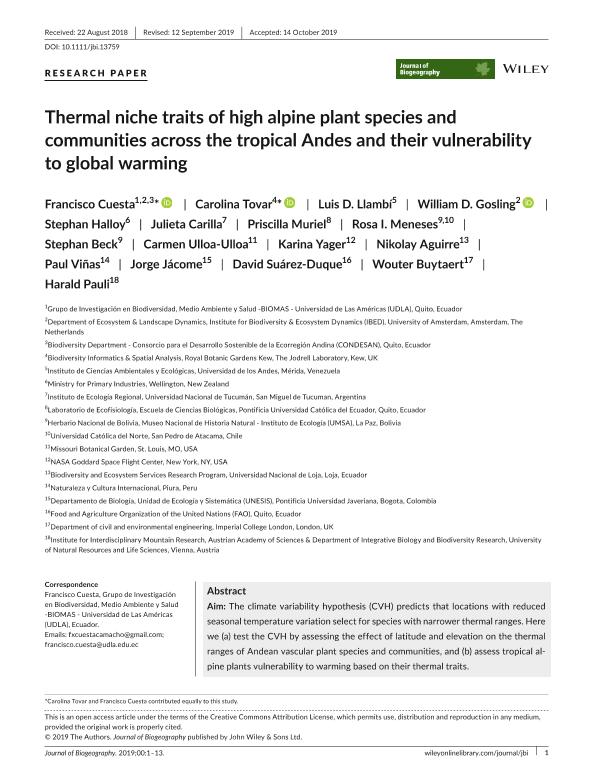Artículo
Thermal niche traits of high alpine plant species and communities across the tropical Andes and their vulnerability to global warming
Cuesta, Francisco; Tovar Ingar, Carolina; Llambí, Luis D.; Gosling, William D.; Halloy, Stephan; Carilla, Julieta ; Muriel, Priscilla; Meneses, Rosa I.; Beck, Stephan G.; Ulloa Ulloa, Carmen; Yager, Karina; Aguirre, Nikolay; Viñas, Paul; Jácome, Jorge; Suárez Duque, David; Buytaert, Wouter; Pauli, Harald
; Muriel, Priscilla; Meneses, Rosa I.; Beck, Stephan G.; Ulloa Ulloa, Carmen; Yager, Karina; Aguirre, Nikolay; Viñas, Paul; Jácome, Jorge; Suárez Duque, David; Buytaert, Wouter; Pauli, Harald
 ; Muriel, Priscilla; Meneses, Rosa I.; Beck, Stephan G.; Ulloa Ulloa, Carmen; Yager, Karina; Aguirre, Nikolay; Viñas, Paul; Jácome, Jorge; Suárez Duque, David; Buytaert, Wouter; Pauli, Harald
; Muriel, Priscilla; Meneses, Rosa I.; Beck, Stephan G.; Ulloa Ulloa, Carmen; Yager, Karina; Aguirre, Nikolay; Viñas, Paul; Jácome, Jorge; Suárez Duque, David; Buytaert, Wouter; Pauli, Harald
Fecha de publicación:
19/02/2020
Editorial:
Wiley Blackwell Publishing, Inc
Revista:
Journal of Biogeography
ISSN:
0305-0270
Idioma:
Inglés
Tipo de recurso:
Artículo publicado
Clasificación temática:
Resumen
Aim: The climate variability hypothesis (CVH) predicts that locations with reduced seasonal temperature variation select for species with narrower thermal ranges. Here we (a) test the CVH by assessing the effect of latitude and elevation on the thermal ranges of Andean vascular plant species and communities, and (b) assess tropical alpine plants vulnerability to warming based on their thermal traits. Location: High tropical Andes. Taxon: Vascular plants. Methods: Temperature data for 505 vascular plant species from alpine communities on 49 summits, were extracted from 29,627 georeferenced occurrences. Species thermal niche traits (TNTs) were estimated using bootstrapping for: minimum temperature, optimum (mean) temperature and breadth (maximum-minimum). Plant community-weighted scores were estimated using the TNTs of their constituent species. CVH was tested for species, biogeographical species groups and communities. Vulnerability to global warming was assessed for species, biogeographical species groups and communities. Results: Species restricted to the equator showed narrower thermal niche breadth than species whose ranges stretch far from the equator, however, no difference in niche breadth was found across summits’ elevation. Biogeographical species groups distributed close to the equator and restricted to alpine regions showed narrower niche breadth than those with broader ranges. Community-weighted scores of thermal niche breadth were positively related to distance from equator but not to elevation. Based on their TNTs, species restricted to equatorial latitudes and plant communities dominated by these species were identified as the most vulnerable to the projected 1.5°C warming, due to a potentially higher risk of losing thermal niche space. Main conclusions: Our study confirms that the CVH applies to high tropical Andean plant species and communities, where latitude has a strong effect on the thermal niche breadth. TNTs are identified as suitable indicators of species’ vulnerability to warming and are suggested to be included in long-term biodiversity monitoring in the Andes.
Archivos asociados
Licencia
Identificadores
Colecciones
Articulos(IER)
Articulos de INSTITUTO DE ECOLOGIA REGIONAL
Articulos de INSTITUTO DE ECOLOGIA REGIONAL
Citación
Cuesta, Francisco; Tovar Ingar, Carolina; Llambí, Luis D.; Gosling, William D.; Halloy, Stephan; et al.; Thermal niche traits of high alpine plant species and communities across the tropical Andes and their vulnerability to global warming; Wiley Blackwell Publishing, Inc; Journal of Biogeography; 47; 2; 19-2-2020; 408-420
Compartir
Altmétricas



